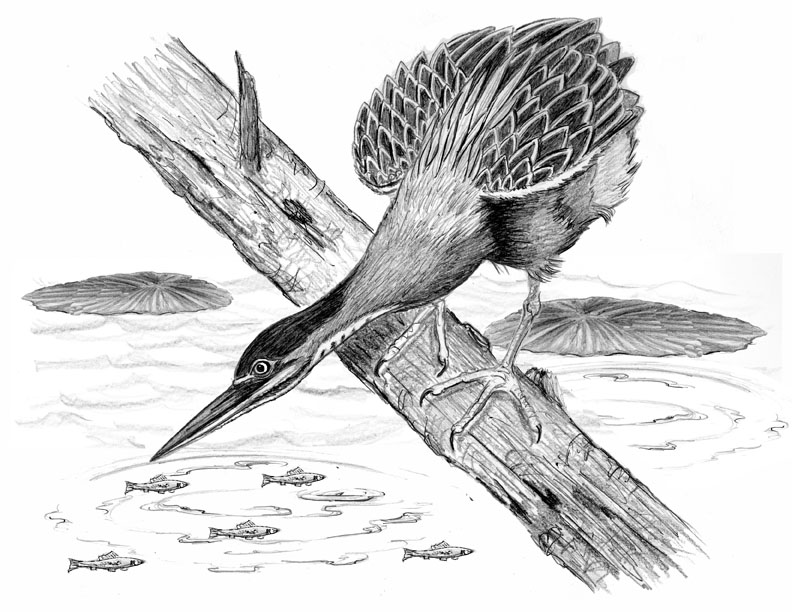
Dear Bird Folks,
There is a nest of Green Herons in our backyard and today we noticed that all of the birds have suddenly disappeared. We’re wondering if something bad has happened to the chicks or have they simply gotten big enough to move out on their own?
– Rich, Sandwich, MA
Good question, Rich,
That’s a very good question. It’s too bad I can’t give you a very good answer. It’s not that I don’t want to help, but there are just too many missing pieces to your puzzle. The most important missing piece is the age of the chicks when they disappeared. If they were, say, seven days old when they vanished, then the news isn’t going to be very good. But, if they left your yard after being in the nest for several weeks, then the news is likely to be much better. So, here is what I’m going to do. I’ll give you some information on Green Herons and then you can draw your own conclusions. That way, if you feel the news is bad, you can’t blame it on me. It’s all about having plausible deniability…or something like that.
The first thing you need to know about Green Herons is that their common name isn’t accurate. They simply aren’t very green. Their coloring pales in comparison to truly green items such as pickles, or lima beans or my drunken relatives on St. Patrick’s Day. A much better field mark is the rich chestnut coloring on their necks. It’s possible that early ornithologists wanted to call them “chestnut-necked herons,” but ultimately decided it was too hard to say. (Try saying “chestnut-necked herons” three times in a row and you’ll see what I mean.)
Green Herons are one of our smallest herons. In fact, it would take over ten Green Herons to equal the weight of a single Great Blue Heron. Yet, the little herons do something that their big cousins don’t do. They go fishing…with actual bait. Most herons spend their days standing in water, waiting for a delicious fish to swim within range. But as I’ve just pointed out, Green Herons aren’t very big and sometimes the fish are in water that is over their heads. (I’m talking about the water being over the herons’ heads, not the fishes’. Fish don’t mind when water is over their heads;actually, they prefer it that way.) One method the birds use to access deep water is to climb out onto an overhanging branch and search for fish while facing head down, nuthatch style. If there aren’t any overhanging branches, some Green Herons use a different trick. While standing on the shore, they will drop pieces of bark, twigs, insects, or even bits of bread into the water. Upon seeing these mysterious objects, the fish come in for a closer look…and that’s the end of that. I’ve watched several online videos that show Green Herons catching fish via this clever method. If you don’t believe me, check them out yourself (because everything on the Internet is true).
Green Herons can’t handle our frigid winters, so they move south each fall. But come the following spring they are back here looking for a place to build a nest. While Great Blue Herons tend to nest in large colonies, Green Herons aren’t nearly as gregarious. In addition, most herons prefer to nest in wetlands, but Green Herons don’t always adhere to that rule. This means a Green Heron couple will build their nest in a variety of locations, including our backyards. In fact, Rich, you might even find a heron nest in your yard one day. Oh, wait. You already have a nest in your yard, which is the reason for your question. (I really need to pay more attention.)
It is thought that Green Heron couples pair-up during migration, so they are ready to get busy the minute they arrive. Their first order of business is to build a nest, which isn’t really anything special. Their nest looks a bit like a pile of “pick-up sticks” dropped onto a tree branch. It normally takes about three weeks of incubating for the eggs to hatch. For the first few days the chicks are pretty quiet, but by the seventh day they are up and stretching their wings. At the end of week number two, the chicks will start climbing onto nearby branches and a week after that they’ll begin making short flights. Thus, if my calculations are correct, baby Green Herons are out and on the move six weeks after their mother begins incubating. This brings us to your questions: what happened to your young herons? In order to answer that, I have to do even more math. Do you have any paper?
Green Herons are typically back on Cape Cod by the first of May. If we allow them two weeks to build a nest, three weeks to incubate their eggs and three more for the chicks to fledge, it means their kids will be on their own by the end of June, or so. Therefore, if your herons disappeared in early July, they are most likely fine. However, if you last saw them in mid-June, the news isn’t so good. Green Heron nestlings can fall victim to a variety of predators including raccoons, owls and kids playing pick-up sticks.
Based on your scant information, Rich, it’s hard to know exactly what happened to your herons. However, for the sake of making us all feel good, I declare that all of the chicks flew away and are in a nearby marsh as we speak, getting their first fishing lesson. You know, now that I think about it, I was in a sporting goods shop yesterday, where I saw three young herons buying a bucket of bait. I’ll bet they were your birds.